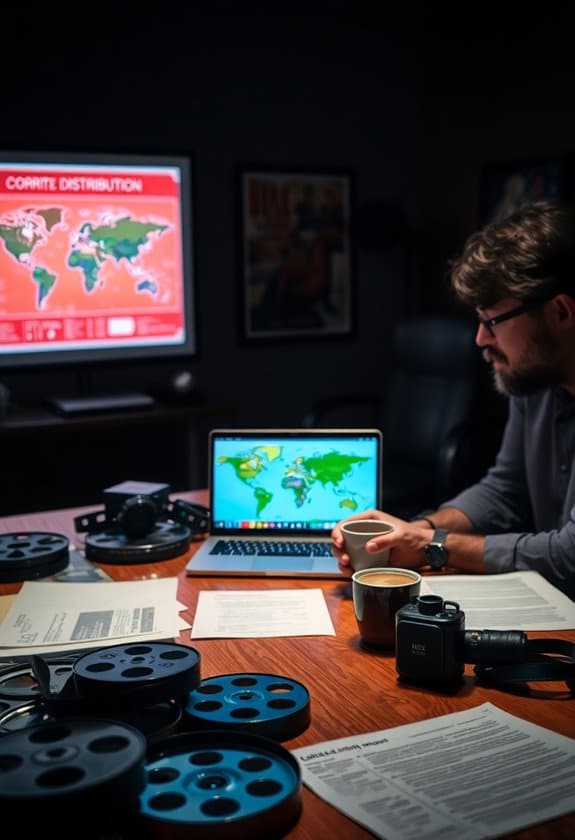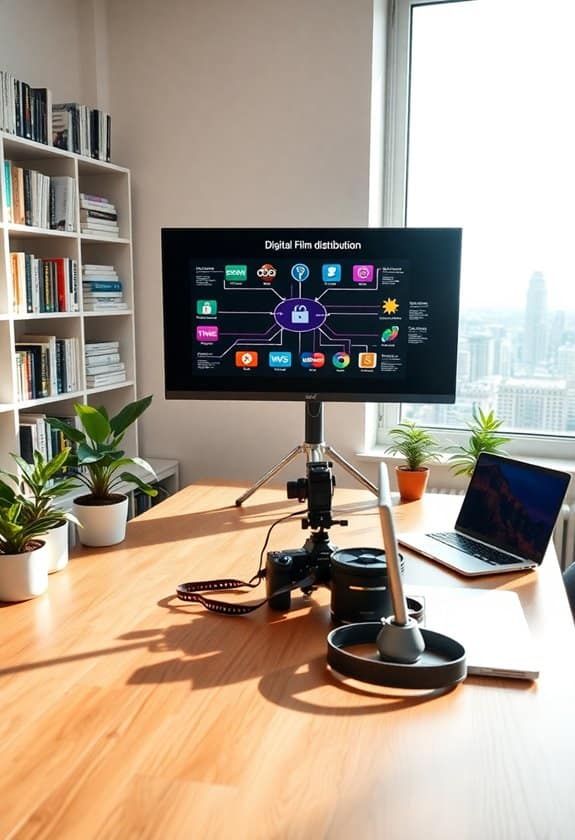You’ve finished your film, and now it’s distribution time—a bit like sending your baby off to school. Film distribution is what helps movie lovers everywhere enjoy your masterpiece. You’ve got traditional methods like theaters and DVDs—classic, but still solid choices. However, digital platforms like Netflix and YouTube can make your film available worldwide in a flash. You’ll need savvy negotiation skills to secure the right deals and contracts, ensuring your creative vision remains intact. Plus, marketing is your best friend; think catchy trailers and exciting social media buzz. Dive deeper with us to see how your film can shine.
Important Highlights
- Film distribution connects filmmakers to audiences through various channels, ensuring the film’s availability and engagement.
- Traditional distribution includes theatrical releases, TV broadcasts, and DVDs, offering familiarity and security.
- Digital platforms like Netflix and Amazon Prime provide cost-effective global access and creative control.
- Securing distribution deals involves strategic planning, professional pitches, and fair negotiations.
- Effective marketing through posters, trailers, and social media is crucial for a film’s visibility and success.
Understanding Film Distribution

Film distribution is the lifeline connecting filmmakers with audiences, ensuring that a film reaches viewers through various channels.
Imagine your film as a treasure, waiting to be discovered. Without distribution, it might remain hidden forever.
You’ll find that distribution can be a bit like traversing a maze, but don’t worry, you’re not alone. It involves planning how to get your film safely out there, from securing rights to choosing the right platforms.
You want your film to be seen, but it’s also important to protect your work from any unwanted surprises.
I once saw a friend’s film soar after finding the perfect distribution path.
It’s not just about the journey; it’s about ensuring your film lands safely in the hearts of viewers.
Traditional Distribution Channels

As you explore the landscape of film distribution, one of the first paths you’ll encounter is traditional distribution channels.
Imagine this: your film is carefully packed onto reels (or hard drives), journeying to movie theaters where enthusiastic audiences await. It’s a bit like sending your child off to their first day of school—exciting yet nerve-wracking.
Traditional channels include theatrical releases, TV broadcasts, and physical media like DVDs. These avenues have been around for ages, providing a sense of security and familiarity.
I remember my first film’s theatrical release; it was thrilling to see it on the big screen.
While it can be challenging, partnering with a reliable distributor helps guarantee your film reaches theaters safely, making all your hard work worthwhile.
Digital Distribution Platforms

Step into the future of film distribution with digital platforms that have revolutionized how audiences access content.
Imagine your film reaching viewers worldwide, safely and efficiently. It’s like having a magic carpet, only with fewer genies and more pixels.
Digital platforms such as Netflix, Amazon Prime, and YouTube offer filmmakers like you incredible opportunities to showcase their work.
Here’s why they’re awesome:
- Wide Reach: Instantly connect with audiences across the globe, breaking geographical barriers.
- Cost-Effective: Save on expensive physical distribution, keeping your budget safe and sound.
- Flexibility: Release films on your schedule, maintaining control over your creative vision.
Navigating these platforms can seem intimidating, but remember, it’s all about sharing your passion for filmmaking with the world in the safest way possible.
Securing Distribution Deals

Securing distribution deals is a crucial step in getting your film in front of audiences and requires strategic planning and negotiation.
You’ve poured your heart into making your film, and now it’s time to find the right partner to help it shine. Start by researching potential distributors who align with your film’s genre and audience.
Reach out with a professional, friendly pitch; think of it like inviting someone to watch your favorite movie. Be clear about your film’s unique qualities, but keep it concise.
During negotiations, prioritize transparency and fairness; it’s like picking a trustworthy friend. Remember, it’s okay to ask questions.
Protect your creative vision, and don’t rush into agreements. Take your time, and trust your instincts to find the safest path forward.
Marketing Your Film

Marketing your film is an essential task that can make or break its success. Imagine pouring your heart into a project only to have it fade away unnoticed.
To keep your film safe from obscurity, consider these steps:
- Build a Buzz: Create excitement with eye-catching posters and trailers. People love to buzz about something new and exciting!
- Engage on Social Media: Share behind-the-scenes stories and sneak peeks. You’ll build a community that feels like they’re part of the journey.
- Host Screenings: Organize local screenings; nothing beats watching your film with an enthusiastic crowd.
I remember feeling nervous before my first screening, but seeing the audience’s smiles made it all worth it.
Marketing takes effort, but it guarantees your film’s safety and success.
Navigating Distribution Contracts

After ensuring your film gets the attention it deserves, it’s time to explore the world of distribution contracts. These contracts can seem tricky, but don’t worry—you’ve got this!
Imagine them as the rules that decide how, where, and when your film gets shared with the world. Always check the fine print, as it’s like reading a treasure map—full of clues about what you’ll get in return for your masterpiece.
Look for details like rights and revenue splits, making sure it’s fair and clear. Once, I almost signed a contract without knowing I’d lose creative control. Yikes!
Frequently Asked Questions
What Role Do Film Festivals Play in Securing Distribution?
Imagine your film as a hidden gem, waiting to be discovered. Film festivals are the treasure maps that lead distributors to you.
They’re not just about the red carpets and flashing cameras; they’re safe spaces where your work gets the spotlight.
At festivals, you meet industry insiders, who could champion your film to those who can make it shine worldwide.
How Do Independent Filmmakers Finance Distribution Costs?
You might be wondering how independent filmmakers handle distribution costs.
Well, it’s like planning a big pizza party without a budget. You can seek help from crowdfunding platforms where fans chip in, or team up with distributors who share the expenses.
Some filmmakers also apply for grants or sponsorships.
Remember, it’s all about creativity and persistence—just like making your first film.
And hey, sometimes mom’s leftover lasagna saves the day!
What Are the Key Differences Between Domestic and International Distribution?
You might think domestic and international distribution are the same, but they’re not.
Domestically, you’re playing on familiar turf, maneuvering local laws and audiences.
Internationally, it feels like juggling flaming swords—each country has its own rules and cultural nuances.
It’s like when I tried to show my indie film abroad; I didn’t just need subtitles, I needed a whole new marketing plan!
How Can Filmmakers Protect Their Intellectual Property During Distribution?
When you’re distributing your film, protecting your intellectual property is essential.
Start by registering your work with the appropriate authorities, like the U.S. Copyright Office. Contracts are your best friends—always outline rights and responsibilities clearly. Trust me, avoiding vague agreements can save you headaches.
Also, consider watermarking your film. I once had a friend whose film was shared without permission. A watermark saved the day!
Keep an eye on online platforms to spot unauthorized use.
What Are Common Challenges Faced in Distribution for Niche Genres?
Picture a brave knight trying to cross a rickety bridge to reach an audience on the other side.
That’s you, tackling niche film distribution. You’ll face challenges like limited audience appeal, which can feel like trying to convince a cat to swim.
Building a network is key; think of it as gathering allies. Protect your vision, and don’t be afraid to share your passion.




